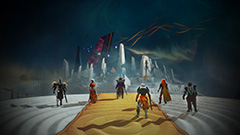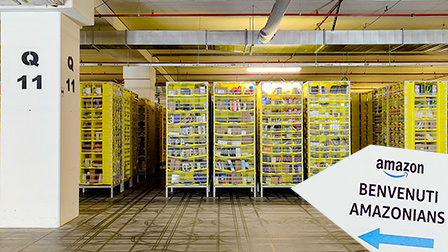|
|||||||
|
|
|
 |
|
|
Strumenti |
|
|
#1 |
|
Bannato
Iscritto dal: Aug 2001
Città: Berghem Haven
Messaggi: 13513
|
Themis e l'aurora boreale
Researchers working on NASA’s Themis mission claim to have solved the 50 year-old mystery of what mechanism drives Earth’s auroras, or Northern and Southern Lights. They say it will help in the prediction of “space weather” that can harm astronauts and wreak havoc with both orbiting and ground-based electrical systems. Scientists know that auroras are the result of electrons and other charged particles in the Earth’s magnetic blanket or “magnetosphere” colliding in the upper atmosphere. They also know that the occasional increases in size, brightness and colouring of the lights are caused by disturbances in the magnetosphere called substorms. However, there has never been consensus on how these substorms are triggered. “More importantly for us, they have effects for life [on Earth],” said Nicky Fox, deputy project scientist on the Themis mission, in a press conference yesterday evening. “Everyone is familiar with changes in weather, but weather also occurs in space. “This space weather describes the solar-driven effect that can influence the performance and reliability of satellites and ground-based technological systems such as power grids and pipelines, and it can also affect astronauts in orbit.” The Sun ‘sneezes’ The $200m Themis mission, which launched almost a year and a half ago, comprises five identical satellites orbiting the Earth at different heights. This widespread group has proved essential to track the effects of substorms, which can be felt over a huge volume of space within a couple of minutes. On 26 February this year Themis spotted an isolated substorm shortly before a network of ground-based observatories detected an auroral brightening over the northern US. The data collected verifies a mechanism for the triggering of substorms. In this mechanism, the solar wind — a continuous outflow of charged particles driven by the Sun’s magnetic field — sometimes approaches Earth in an opposite polarity to our planet’s magnetic field. When this happens, the magnetic field lines stretch until they finally snap together — a process called “reconnection”, which releases an explosion of magnetic energy. This energy travels from the Sun to the Earth and, when enough has entered the magnetosphere, it produces a substorm that culminates in the formation of an aurora (Science Express doi:10.1126/science.1160495). “If the Sun changes, the Earth will feel its effects,” continued Fox. “So it’s kind of like if the Sun sneezes, the Earth will catch a cold.” |
|
|

|
|
|
#2 |
|
Bannato
Iscritto dal: Aug 2001
Città: Berghem Haven
Messaggi: 13513
|
http://www.dailytech.com/NASA+Solves...ticle12494.htm
The aurora borealis, also known as the northern lights, has been a puzzle to scientist for over 30 years. The mystery to science was how exactly the phenomenon was started in the atmosphere. According to Space.com, scientists were unsure if the aurora was started as magnetic field lines in the atmosphere reconnected or if the aurora originated closer to Earth as the result of explosive instability. NASA used its five THEMIS spacecraft orbiting the Earth to spot the trigger for the substorms that cause the aurora to develop. The trigger was very strong energy bursts in the Earth’s magnetic field. The THEMIS probes monitored the level of energy in the Earth’s magnetic field. The probes were able to find substorms that originated in the tail of the Earth’s magnetosphere that flows away from the sun. As energy levels in the magnetic field lines build the lines drew closer to each other until they reconnected. Once the magnetic field lines reconnected a storm was set off in the magnetosphere leading to the aurora borealis. Space scientist Vassilis Angelopoulos from the University of California in L.A. told Space.com, “We discovered what sparks the magnificent light show of the aurora. Our data show clearly and for the first time that magnetic reconnection is the trigger.” According to the scientists, the better they can understand the storms that spark the aurora, the better they will be able to prepare for or predict space weather events that can interfere with communications and endanger any astronauts in orbit at the time. Angelopoulos continued saying, “We need to understand this environment and eventually be able to predict when these large energy releases will happen so astronauts can go inside their spacecraft and we can turn off critical systems on satellites so they will not be damaged.” The THEMIS spacecraft were launched in February 2007 specifically to hunt for the cause of the substorms in the magnetosphere. The mission was set to last two years. Another spacecraft called Image was to study the Earth’s magnetosphere. Image failed unexpectedly in 2006, but the mission was a success as the Image spacecraft was only slated to operate for two years. |
|
|

|
|
|
#3 |
|
Senior Member
Iscritto dal: Oct 2005
Messaggi: 1056
|
tradotto nella lingua di noi comuni mortali?
Cazzo un po di inglese lo so ma in sti articoli non si capisce neanche di cosa parlano tra un po. |
|
|

|
|
|
#4 |
|
Member
Iscritto dal: Dec 2005
Città: Sulbiate (MB)
Messaggi: 291
|
__________________
http://www.francescopassoni.com/
|
|
|

|

|
| Strumenti | |
|
|
Tutti gli orari sono GMT +1. Ora sono le: 00:17.






















